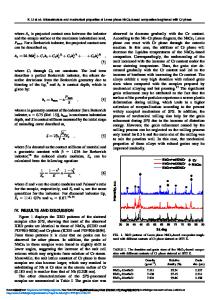The Effect of Ternary Addition on Structure and Stability of NbCr 2 Laves Phases
- PDF / 524,586 Bytes
- 9 Pages / 612 x 792 pts (letter) Page_size
- 4 Downloads / 350 Views
MATERIALS RESEARCH
Welcome
Comments
Help
The effect of ternary addition on structure and stability of NbCr2 Laves phases T. Takasugi Institute for Materials Research, Tohoku University, Katahira 2-1-1, Aoba-ku, Sendai 980-8577, Japan
M. Yoshida Miyagi National College of Technology, Natori, Miyagi Prefecture, 981-1239, Japan (Received 10 December 1996; accepted 6 January 1997)
The alloying effect on microstructure and stability of the NbCr2 Laves phases is investigated using x-ray diffraction (XRD) and transmission electron microscopy (TEM). In as-cast condition, the binary alloy as well as the ternary alloy containing V consisted of the C15 phase while the ternary alloys containing Mo, Ti, and W consisted of both the C14 (or C36) and the C15 phases, accompanied by a number of stacking faults and microtwins in their constituent phases. By a prolonged heat treatment at 1673 K, the retained C14 (or C36) phase is completely transformed to the C15 phase. However, their kinetics is slower in the sequence of the ternary alloys containing Mo . Ti . W. The alloying effect on the stability of the C15 (or the C14) phase and the associated transformation process is discussed on the basis of phase stability and kinetics.
I. INTRODUCTION
The Laves phase alloy, NbCr2 intermetallic, is attractive for high temperature structural applications because of a high melting point (about 2000 K), low density (7.7 gycm3 ), and potential resistance to corrosion and oxidation. The NbCr2 intermetallic undergoes a phase transition from the C14 to the C15 structures at about 1870 K,1,2 and therefore some studies have been devoted to understanding their phase transformation and resultant microstructure.2–5 Also, some studies have been carried out to understand deformation behavior and related properties of a single phase C15 NbCr2 .4,6–8 The deformability of the single phase C15 NbCr2 has been shown to be poor at room temperature although their high temperature static and creep strengths were excellent.4,6–8 The single phase C15 NbCr2 intermetallic was deformable only at temperatures above 1473 K.4,6–8 Therefore, there have been some attempts to improve the fracture toughness by generating two-phase, NbCr2 based composites with Nb solid solution9,10 and Cr solid solution.10,11 However, those attempts have not been always successful.9–11 From two points of view, ternary alloying has been attempted to improve mechanical properties of the NbCr2 -based intermetallics. One point is that the addition of some refractory elements to the C15 NbCr2 can improve deformability via facilitating deformation of the C15 structure itself, according to a recent analysis (based on a hard sphere model) for the stacking sequence of the AB2 structure.12,13 Fortunately, many refractory elements have been shown to have large solubility in the C15 NbCr2 intermetallics.14 Indeed, some elements such as Mo and V have been found J. Mater. Res., Vol. 13, No. 9, Sep 1998
http://journals.cambridge.org
Downloaded: 19 Mar 2015
to improve the high temperature deformabil
Data Loading...











